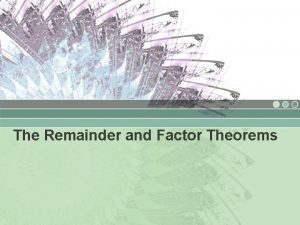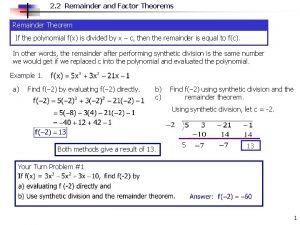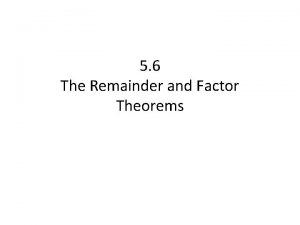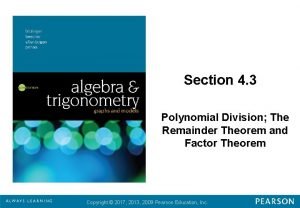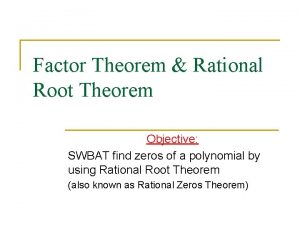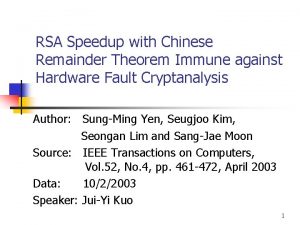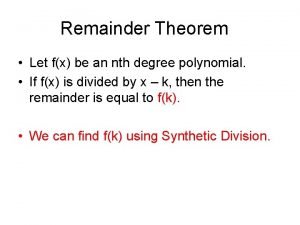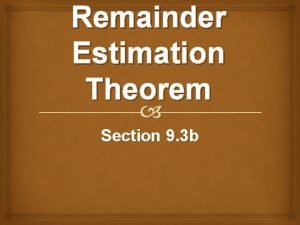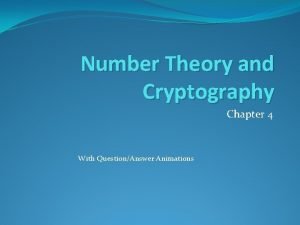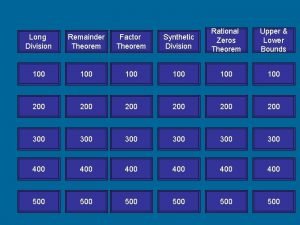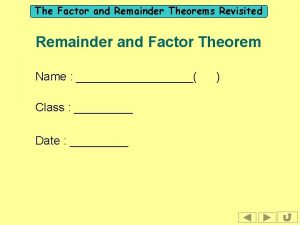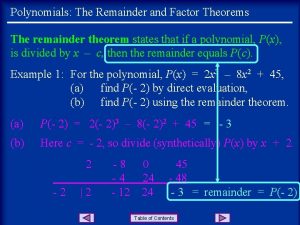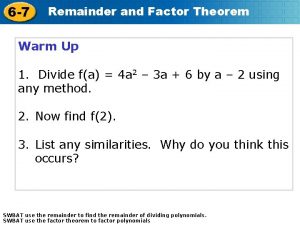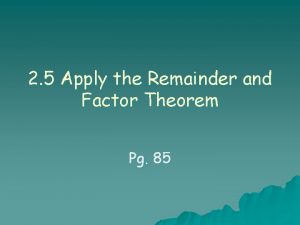REMAINDER THEOREM AND FACTOR THEOREM FUNCTIONAL NOTATION INPUT










- Slides: 10

REMAINDER THEOREM AND FACTOR THEOREM


FUNCTIONAL NOTATION INPUT OUTPUT When then




REMAINDER THEOREM / RESSTELLING Divide Divisor / Deler Quotient / Kwosiënt Dividend / Deeltal Remainder / Res dividend / deeltal divisor / deler quotient / kwosi ënt remainder / res

Remainder Theorem by applying the Functional Notation Die Resstellingdeur die Funksie. Notasie toe te pas. The FACTOR Theorem uses the REMAINDER Theorem to determine whether an EXPRESSION (DIVISOR) is a factor of a FUNCTION (DIVIDEND). For an EXPRESSION to be a FACTOR of a FUNCTION, the REMAINDER must equal ZERO. Die FAKTORSTELLING gebruik die RESSTELLING om te bepaal of ʼn UITDRUKKING (DELER) ʼn FAKTOR van ʼn FUNKSIE (DEELTAL) is. Vir ʼn UITDRUKKING (DELER) om ʼn FAKTOR van ʼn FUNKSIE (DEELTAL) te wees, moet die RES gelyk wees aan NUL.

SYNTHETIC METHOD for LONG DIVISION REMAINDER The dividend is in standard form, descending order. The divisor needs to be rewritten from (x + 2) to x + 2 = 0 then x = -2 Steps: 1. Drop the first coefficient below the horizontal line. 2. Multiply that number you drop by the number in the "box". Whatever its product, place it above the horizontal line just below the second coefficient. 3. Add the column of numbers, then put the sum directly below the horizontal line. 4. Repeat the process until you run out of columns to add. Show your final answer in the form Notice that the numbers below the horizontal line except the last (remainder) are the coefficients of the Quotient. More so, the exponents of the variables of the quotient are all reduced by 1.

 5-6 the remainder and factor theorems
5-6 the remainder and factor theorems What is remainder theorem
What is remainder theorem Factor theorem and remainder theorem
Factor theorem and remainder theorem 5-6 the remainder and factor theorems
5-6 the remainder and factor theorems Synthetic division and the remainder theorem assignment
Synthetic division and the remainder theorem assignment Rational root
Rational root Rsa
Rsa Finding an nth degree polynomial
Finding an nth degree polynomial The remainder estimation theorem
The remainder estimation theorem Chinese remainder theorem example
Chinese remainder theorem example Factor theorem and synthetic division
Factor theorem and synthetic division
